
Shop Group Plans
Employer Resources
Broker Resources
Value-based care designed to deliver maximum cost savings

Now more than ever, business leaders need to ensure they’re getting the most value for each health care dollar they spend. A workforce health solution that excels at prevention, effectively controls chronic conditions, and supports better outcomes over time will set up your employees — and your business — for success.
Integrated care and coverage that optimizes workforce health
At Kaiser Permanente, primary care, specialty care, pharmacy, labs, medical facilities, and health plans all work together in one coordinated and connected system. This eliminates the redundancies and inefficiencies that are so prevalent in other health care organizations — and creates cost-saving opportunities our competitors simply cannot match.
Plus, our incentives align with yours. Our doctors are rewarded for providing the right care — not more care. That means their sole motivation is to achieve the healthiest outcomes — for every member, at every stage of life, and in every level of care.
A connected system built to maximize value



Ready to discuss health plans for your business? 877-305-7933
Superior preventive care — the key to substantial cost savings
Our system is designed to identify potential risks and diagnose existing health issues before they become serious and costly. Through proactive screening, prevention, and early intervention, we help employees better manage chronic conditions and serious illnesses — or even avoid them altogether.
Plus, embedded electronic alerts remind care teams and members about upcoming or overdue screenings — so even if an employee can’t remember when they had their last screening, they’ll know when they need a new one. And data from more than 12 million members helps us continuously optimize our preventive care practices and spread them quickly across Kaiser Permanente — resulting in unrivaled population health management capabilities that help minimize employer cost and maximize employee health.
Better prevention in action
High blood pressure control — Annual medical costs are $7,418 higher for employees with high blood pressure.1 Nearly 3 out of 4 Kaiser Permanente members with hypertension have it under control — 14% above the national average.2
Cancer screenings — Compared to the national average, our screening rates are 9% higher for breast cancer, 7% higher for cervical cancer, and 11% higher for colorectal cancer.3 This helps us spot cancer sooner and start evidence-based treatment earlier, reducing the need for costly and invasive treatments, and supporting healthier outcomes.


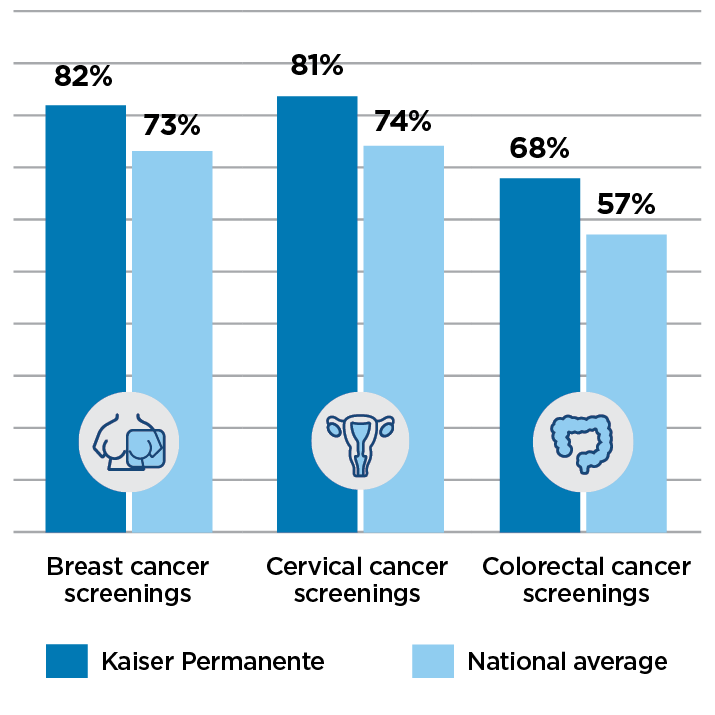
Unparalleled chronic disease management
3 in 5 Americans lives with a chronic disease — and 2 in 5 have more than one.7 With 90% of the nation’s $4.1 trillion in annual health care costs spent on treating these conditions, preventing and managing them is top of mind for employers.8 By empowering high-risk members with the right tools and support, we help many of them stave off chronic diseases like hypertension and diabetes altogether. And for members who live with chronic conditions, we offer robust support that’s automatically added to their care plan — at no additional cost to you or your employees — to help successfully manage them.
Spotlight on care excellence: Diabetes management
Promoting better medication adherence — Adherence to diabetes medication can save $3,365 in health care costs per employee, per year — an average annual savings of 64% compared to diabetic employees who are non-adherent.9 While medication adherence for patients with chronic diseases like diabetes typically hovers between 40% to 50%, more than 75% of Kaiser Permanente members with diabetes take their medications as prescribed.10
Preventing serious and costly complications — Annual employer health care costs are 252% higher for employees with diabetes who develop kidney disease.11 Kaiser Permanente outpaces the nation in providing regular kidney health exams for members with diabetes by 35%.12
Diabetes care that cuts costs and saves lives13, 14
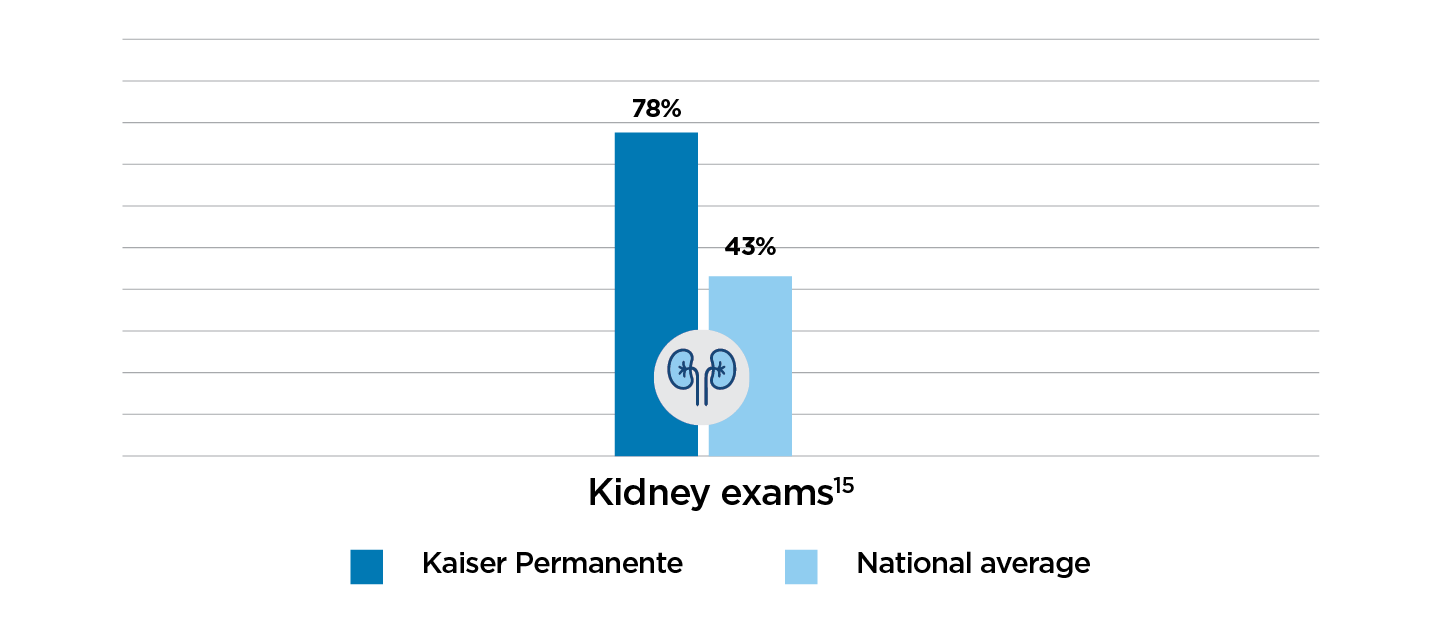

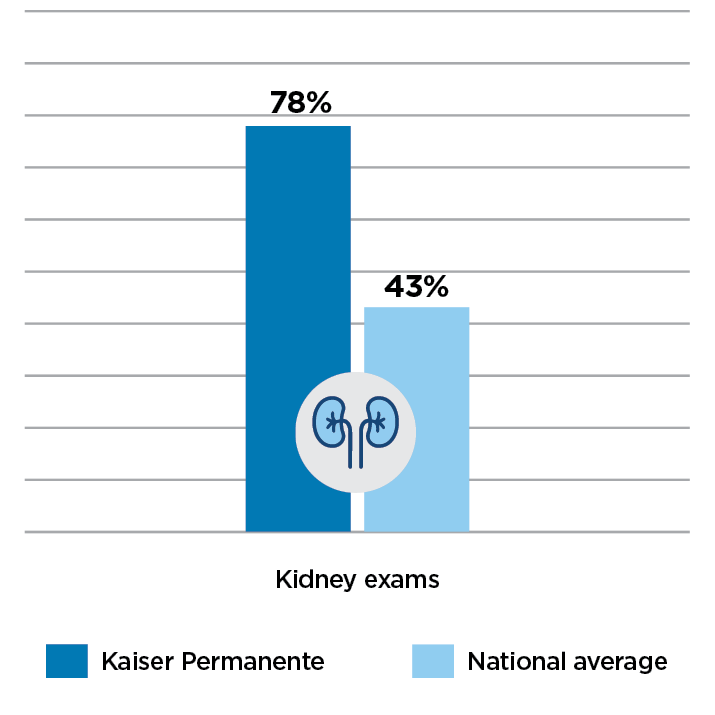
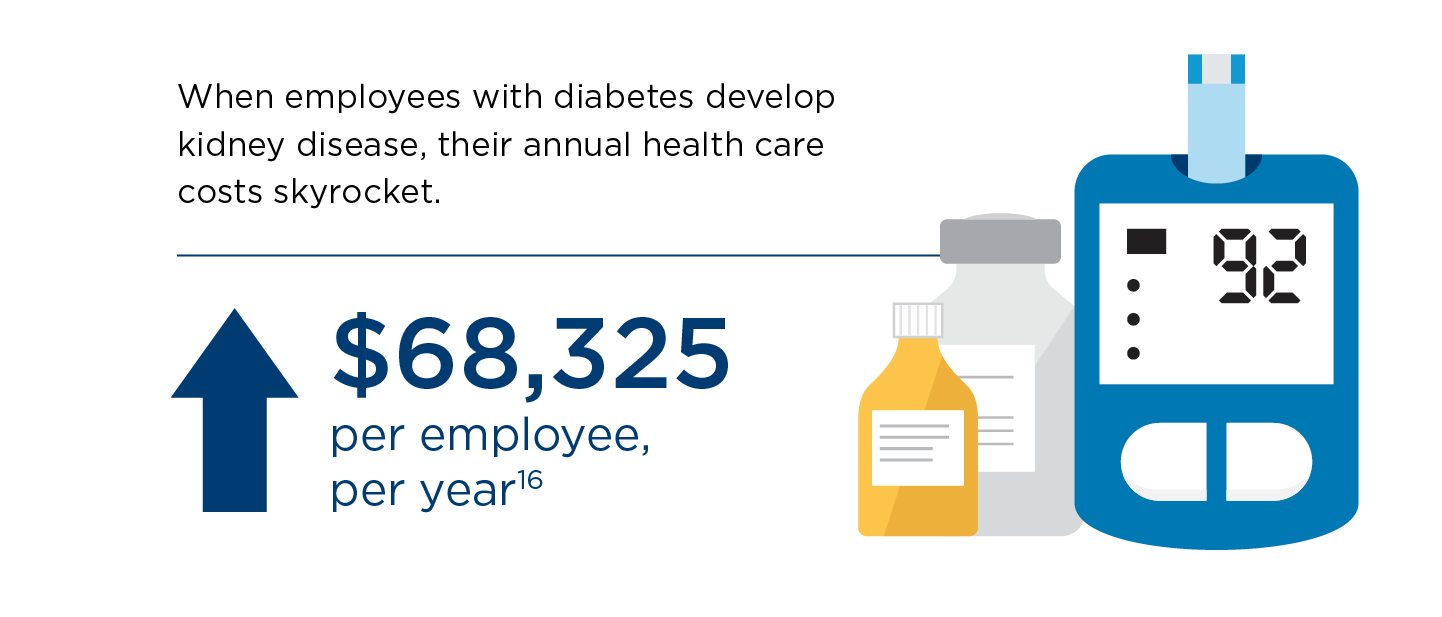

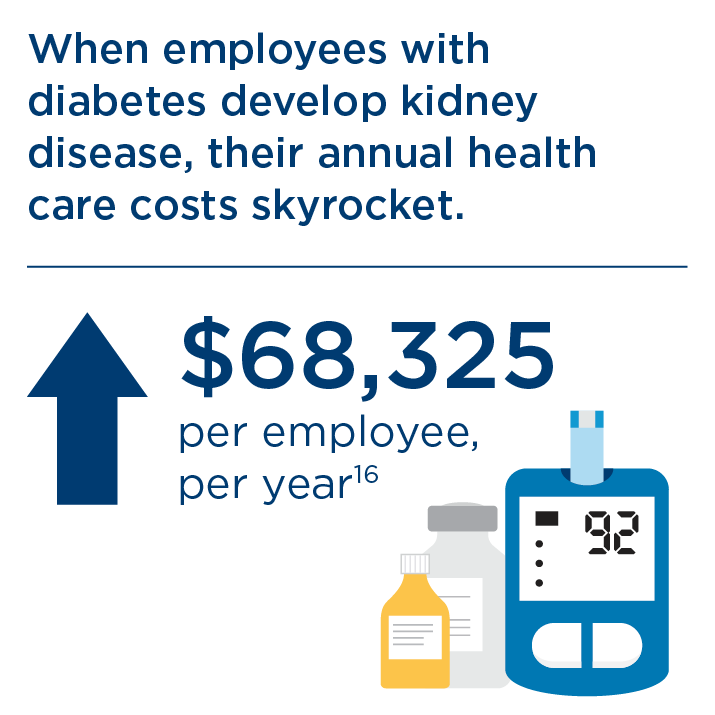
An integrated pharmacy offering massive cost-saving potential
Our integrated model means we oversee the entire pharmacy process, from formulary composition to procurement to dispensing. This structure helps us better control drug costs while maintaining excellent quality — and we pass the savings on to our members and customers.
Unrivaled purchasing power
When it comes to negotiating pharmaceutical prices, size means leverage. We use our size to your advantage, securing best-in-class lower prices from major pharmaceutical vendors.
A cost-efficient approach
- Each 0.1% increase in generic drug utilization can achieve a massive $28 million in savings.17 Generics take priority in our formulary, accounting for 94% of our prescriptions — notably higher than the U.S. average of 90%.18
- Biosimilars cost more than 50% less than brand biologics, and we adopt them faster than other providers.19 For example, we achieved 90% adoption of Amjevita, the highly anticipated biosimilar for costly Humira, within a month of its release — and this is projected to save $300M in 2023 alone.20 Outside Kaiser Permanente, adoption remains less than 10%.21


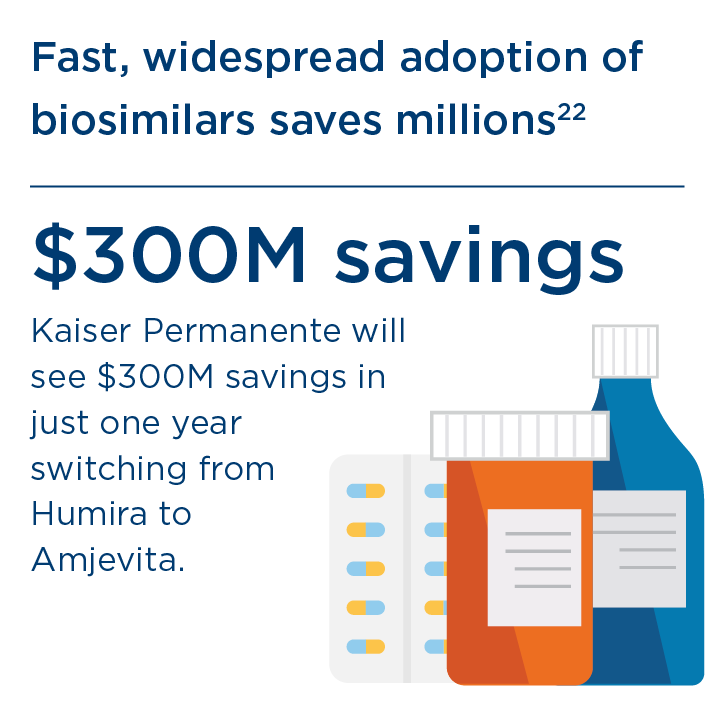
The right health care partner makes all the difference
When it comes to health care, some businesses see consistent return on their investment, while others spend countless dollars trying to make up for the areas where their health plans fall short. Kaiser Permanente has a proven track record of keeping costs down and quality high — consistently delivering better care, better value, and better outcomes. When choosing your health care partner, remember that we’re built to raise the bar for what you can expect from your health plan.
Let's talk about the right plan that delivers the best value for your business. 877-305-7933
Footnotes:
1Jared Ortaliza et al., “How Do Health Expenditures Vary Across the Population?” Peterson-KFF Health System Tracker, November 12, 2021.
2Kaiser Permanente 2023 HEDIS® scores. Benchmarks provided by the National Committee for Quality Assurance (NCQA) Quality Compass® and represent all lines of business. Kaiser Permanente combined region scores were provided by the Kaiser Permanente Department of Care and Service Quality. The source for data contained in this publication is Quality Compass 2023 and is used with the permission of NCQA. Quality Compass 2023 includes certain CAHPS data. Any data display, analysis, interpretation, or conclusion based on these data is solely that of the authors, and NCQA specifically disclaims responsibility for any such display, analysis, interpretation, or conclusion. Quality Compass® and HEDIS® are registered trademarks of NCQA. CAHPS® is a registered trademark of the Agency for Healthcare Research and Quality.
3See note 2.
4Joel V. Brill, “Screening for Cancer, the Economic, Medical, and Psychosocial Issues,” American Journal of Managed Care, November 16, 2020.
5See note 2.
6A bar graph comparing cancer screening rates between Kaiser Permanente and the national average. It includes three categories: Breast cancer screenings (Kaiser Permanente: 82% v. national average: 73%), Cervical cancer screenings (Kaiser Permanente: 81% v. national average: 74%), and Colorectal cancer screenings (Kaiser Permanente: 68% v. national average: 57%)
7“Chronic Diseases in America,” cdc.gov, accessed October 19, 2023.
8“Health and Economic Costs of Chronic Disease,” cdc.gov, accessed October 19, 2023.
9Sanjay K. Rao, PhD, “How Medication Non-Adherence Impacts Brand Management,” Pharmaceutical Executive, March 23, 2021.
10Kaiser Permanente internal data.
11Paige Minemyer, “Here’s How Much Diabetes Costs Employers Each Year,” Fierce Healthcare, March 14, 2023.
12See note 2.
13A bar graph comparing Kaiser Permanente and the national average on kidney exams. Kaiser Permanente, at 78%, performs 35% better than the national average of 43%.
14.When employees with diabetes develop kidney disease, their annual health care costs skyrocket — $68,325 per employee, per year.
15See note 2.
16See note 11.
17Anthony A. Barrueta, “Lowering the Cost of Prescription Drugs: Reducing Barriers to Market Competition,” testimony for the Committee on Energy & Commerce Subcommittee on Health, U.S. House of Representatives, March 13, 2019.
18The U.S. Generic & Biosimilar Medicines Savings Report, Association for Accessible Medicines, October 2021.
19“The U.S. Generic & Biosimilar Medicines Savings Report: September 2022,” Association for Accessible Medicines, September 2022.
20Kaiser Permanente internal data; Kaiser Permanente does not endorse the medications or products mentioned. Any trade names listed are for easy identification only.
21Malhotra, Yaashu, “The AMJEVITA impact: Innovative U.S. biosimilar pricing models,” Clarivate, July 5, 2023.
22Kaiser Permanente internal data.
23The image has a headline that reads, "Fast, widespread adoption of biosimilars saves millions." Additional text highlights "$300M savings," followed by, "Kaiser Permanente will see $300M savings in just one year switching from Humira to Amjevita.